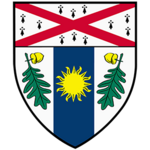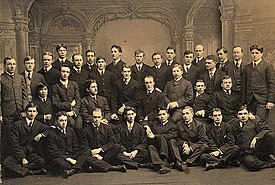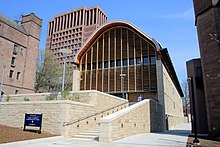 Coat of arms of the school Coat of arms of the school | |
| Established | 1900 (1900) |
|---|---|
| Parent institution | Yale University |
| Dean | Indy Burke |
| Academic staff | 47 |
| Postgraduates | 280 |
| Doctoral students | 75 |
| Location | New Haven, Connecticut, United States 41°19′01″N 72°55′25″W / 41.31694°N 72.92361°W / 41.31694; -72.92361 |
| Website | environment |
Yale School of the Environment (YSE) is a professional school of Yale University. It was founded to train foresters, and now trains environmental students through four 2-year degree programs (Master of Environmental Management, Master of Environmental Science, Master of Forestry, and Master of Forest Science), two accelerated degree programs for graduates of Yale College, and a 5-year PhD program. Still offering forestry instruction, the school has the oldest graduate forestry program in the United States.
The school changed its name to the Yale School of the Environment in July 2020. It was previously the Yale School of Forestry & Environmental Studies.
History

The school was founded in 1900 as the Yale Forest School, to provide high-level forestry training suited to American conditions. At the urging of Yale alumnus Gifford Pinchot, his parents endowed the two-year postgraduate program. At the time Pinchot was serving as Bernhard Fernow's successor as Chief of the Division of Forestry (predecessor of the U.S. Forest Service, USFS). Pinchot released two foresters from the division to start the school: fellow Yale graduate Henry Solon Graves and James Toumey. Graves became the School's first dean and Toumey its second.
When the school opened, other places in the United States offered forestry training, but none had a post-graduate program. (Both Pinchot and Graves had gone to Europe to study forestry after graduating from Yale.) In the fall of 1900, the New York State College of Forestry at Cornell had 24 students, Biltmore Forest School 9, and Yale 7. Despite its small size, from its beginnings the school influenced American forestry. The first two chiefs of the USFS were Pinchot and Graves; the next three were graduates from the school's first decade. Wilderness and land conservation advocate Aldo Leopold graduated in the class of 1909.
In 1915, Yale School of Forestry's second dean, James Toumey, became one of the "charter members", along with William L. Bray of the New York State College of Forestry, by then reestablished at Syracuse University, and Raphael Zon, of the Ecological Society of America. In 1950, the "activist wing" of that society formed The Nature Conservancy.
Besides the school's own forests, Yale has used a number of other sites in the eastern United States for field education over the years. From 1904 to 1926, the summer session leading to a master's degree in forestry was held at Grey Towers and Forester's Hall in Milford, Pennsylvania. Beginning in 1912, Yale classes took occasional field trips to the land of the Crossett Lumber Company in Arkansas. For two decades from 1946 until 1966, the company provided the school a "camp," including cabins and a mess hall, used during spring coursework on forest management and wood products production. Yale students have also used a field camp at the Great Mountain Forest in northwestern Connecticut since 1941.
Reflective of the expanding variety of environmental interests, the school changed its name to the Yale School of Forestry & Environmental Studies in 1972. YSE hosts the bi-annual Yale Environmental Sustainability Summit. The school's 16th and present dean is Ingrid "Indy" Burke, who replaced Sir Peter Crane in October, 2016. The school changed its name to Yale School of the Environment in July 2020 and, within the school, created a distinct Forest School with dedicated faculty and degrees. It also teaches the Yale College undergraduate courses needed for the Environmental Studies major.
Joint programs
Yale School of the Environment offers 17 joint degrees, three of which are external programs with Pace University School of Law, Vermont Law School, and Tsinghua University, Beijing, China.
School buildings




The school offers classes at Kroon Hall, Sage Hall, Greeley Labs, Marsh Hall, the Environmental Science Center, and the houses at 301 Prospect St. and 380 Edwards St. Kroon Hall, the school's main building, is named for the philanthropist Richard Kroon (Yale Class of 1964). The building has 50,000 square feet (5,000 m) of space. It is "a showcase of the latest developments in green building technology, a healthy and supportive environment for work and study, and a beautiful building that actively connects students, faculty, staff, and visitors with the natural world." The building obtained Platinum Rating under the LEED certification system. It is designed by Hopkins Architects of London with Architect of Record Centerbrook Architects & Planners. Goodfellow Inc from Delson, Quebec, supplied the glulam roof structure for this project.
School forest
The school owns and manages 10,880 acres (44 km) of forestland in Connecticut, New Hampshire, and Vermont. The Yale Myers Forest, in Union, Connecticut, donated to Yale in 1930 by alumnus George Hewitt Myers, is managed by the school as a multiple-use working forest. Yale-Toumey Forest, near Keene, New Hampshire, was set up by James W. Toumey (a former dean of the school) in 1913. Other Yale forestlands include Goss Woods, Crowell Forest, Cross Woods, Bowen Forest, and Crowell Ravine. A three-alarm fire burned several buildings within the Yale Myers Forest Camp on May 28, 2016. The damaged camp buildings and a new research center were rebuilt in 2017.
Student life

The school has an active tradition of student involvement in academic and extracurricular life. Many students take part in student interest groups, which organize events around environmental issues of interest to them. These groups range in interest from Conservation Finance and International Development, to the Built Environment and "Fresh & Salty: The Society for Marine and Coastal Systems.”There are also social and recreational groups, such as the Forestry Club, which every Friday organizes themed "TGIF" ("Thank-God-I'm-a-Forester") happy hours and school parties; the Polar Bear club, which swims monthly in Long Island Sound under the full moon (year-round); Veggie Dinner, which is a weekly vegetarian dinner club; the Loggerrhythms, an a cappella singing group; and the student-run BYO Café in Kroon Hall opened in 2010. A notable YSE tradition is the extravagant environmentally inspired decoration of graduation caps in preparation for commencement.
Notable graduates
- Matthew Auer '96 PhD, Dean and Arch Professor, University of Georgia School of Public and International Affairs
- Frances Beinecke '71 BA, '74 MFS, President, Natural Resources Defense Council; member, National Commission on the BP Deepwater Horizon Oil Spill and Offshore Drilling (2010)
- Richard M. Brett, conservationist
- Ian Cheney '02 BA, '03 MEM, Emmy-nominated filmmaker
- William Wallace Covington,'76 PhD Regents' Professor, Northern Arizona University
- Justin Elicker '10 MEM, mayor of New Haven, Connecticut
- Alphonse "Buddy" Fletcher Jr., '04 MEM
- Emanuel Fritz, professor known as "Mr. Redwood"
- Carmen R. Guerrero Pérez '10 MEM, director of the Caribbean Environmental Protection Division of the Environmental Protection Agency
- William B. Greeley, Chief, U.S. Forest Service, 1920–1928
- Christopher T. Hanson '96 M.E.M./M.A.R. Chairman, Nuclear Regulatory Commission, 2021–
- Stuart L. Hart '76 MFS, academic addressing global poverty and economic development, professor emeritus at Cornell University
- Phillip Hoose '77 MFS, author
- Ralph Hosmer, pioneering Hawaiian forester
- Edward M. Kennedy Jr. '91 MES, attorney and Connecticut state senator
- Aldo Leopold '08, conservationist and author of A Sand County Almanac
- H. R. MacMillan, forester and industrialist
- John R. McGuire, Chief, U.S. Forest Service, 1972–1979
- Thornton T. Munger, pioneering U.S. Forest Service researcher; civic activist who helped create Portland, Oregon's Forest Park
- Mark Plotkin '81 MFS, ethnobotanist, explorer, and activist
- Robert Michael Pyle'76 PhD, lepidopterist and John-Burroughs-Medal–winning author, subject of The Dark Divide
- Samuel J. Record, botanist
- Arthur Cuming Ringland,'05, District Forester, Southwestern Region, U.S. Forest Service, 1908-1916, Co-founder CARE
- Ferdinand A. Silcox, Chief, U.S. Forest Service, 1933–1939
- David Martyn Smith, forester and educator, author of The Practice of Silviculture
- Robert Y. Stuart, Chief, U.S. Forest Service, 1928–1933
- Dorceta E. Taylor ’85 MFS, ’91 PhD, environmental sociologist and preeminent scholars in the field of environmental justice, Yale University
- Rae Wynn-Grant '10 MESc, large carnivore ecologist and a fellow with National Geographic Society.
- Mirei Endara de Heras '94 MES, Panamanian government official and board member of Fundación Smithsonian
- Eleanor J. Sterling '93 PhD, conservation scientist, American Museum of Natural History
References
- ^ Sparhawk, W.N. (1949). "The History of Forestry in America". Trees: Yearbook of Agriculture. Washington, D.C.: United States Department of Agriculture. p. 710. Retrieved 28 March 2014.
- Pinchot, Gifford (1998). Breaking New Ground. Island Press. p. 152. ISBN 9781559636704.
- "Growing a Tree Army: Historic Photos of Michigan's USFS Nurseries". foresthistory.org. Retrieved October 29, 2021.
- ^ "You are being redirected..." esa.org. Retrieved 21 April 2018.
- "National Historic Landmarks & National Register of Historic Places in Pennsylvania" (Searchable database). CRGIS: Cultural Resources Geographic Information System. Note: This includes Steiner, Ben; Husson, Leon; Helfrich, Carson O. (December 1982). "National Register of Historic Places Inventory Nomination Form: Forester's Hall" (PDF). Retrieved 2012-05-30.
- Darling, Jr., O. H.; Norman, Bill. "Yale Camp". The Encyclopedia of Arkansas History & Culture. Retrieved 28 March 2014.
- "History: About Us". Great Mountain Forest. Retrieved 28 March 2014.
- "Biogeochemist Indy Burke named dean of Yale's School of Forestry & Environmental Studies", YaleNews, Yale University, retrieved March 8, 2017
- "Yale F&ES to Become the Yale School of the Environment". environment.yale.edu. Retrieved October 29, 2021.
- Yale School of the Environment: Master’s Programs
- Bosselmann, Klauss (2010). Berkshire Encyclopedia of Sustainability Vol. 3: Law and Politics of Sustainability. Berkshire Publishing Group. p. 147. ISBN 978-1933782140.
- ^ "Kroon Hall". Yale School of Forestry & Environmental Studies. Retrieved 28 March 2014.
- "Yale School Forests". Yale School of Forestry & Environmental Studies. Retrieved 28 March 2014.
- "Fire claims four F&ES buildings". yaledailynews.com. Retrieved 21 April 2018.
- Brown, Timothy. "Newly Rebuilt Yale Myers Camp Showcased at Annual Harvest Festival". Yale School of the Environment. Retrieved 2020-07-02.
- Henderson, Drew (18 February 2010). "Kroon opens student café". Yale Daily News. Retrieved 29 January 2011.
- "Graduation snapshots". environment.yale.edu. Retrieved 21 April 2018.
- Faxon, Hilary (13 September 2007). "Alum's gift funds FES aid offerings". Yale Daily News. Retrieved 28 March 2014.
External links
| Yale University | |||||||||||
|---|---|---|---|---|---|---|---|---|---|---|---|
| People |
|  | |||||||||
| Schools |
| ||||||||||
| Campus | |||||||||||
| Residential | |||||||||||
| Library and museums | |||||||||||
| Research | |||||||||||
| Athletics |
| ||||||||||
| Artistic | |||||||||||
| Traditions | |||||||||||
| Publications | |||||||||||